Establishing a strong brand identity in the fiercely competitive market is essential for businesses striving to stand out amidst the noise. As consumers are bombarded with countless options, a brand that resonates with them on a deeper level has a significant advantage. Enter the Brand Identity Prism—a powerful tool that defines a brand's essence and guides its strategic direction in the marketplace.
What is Brand Identity Prism
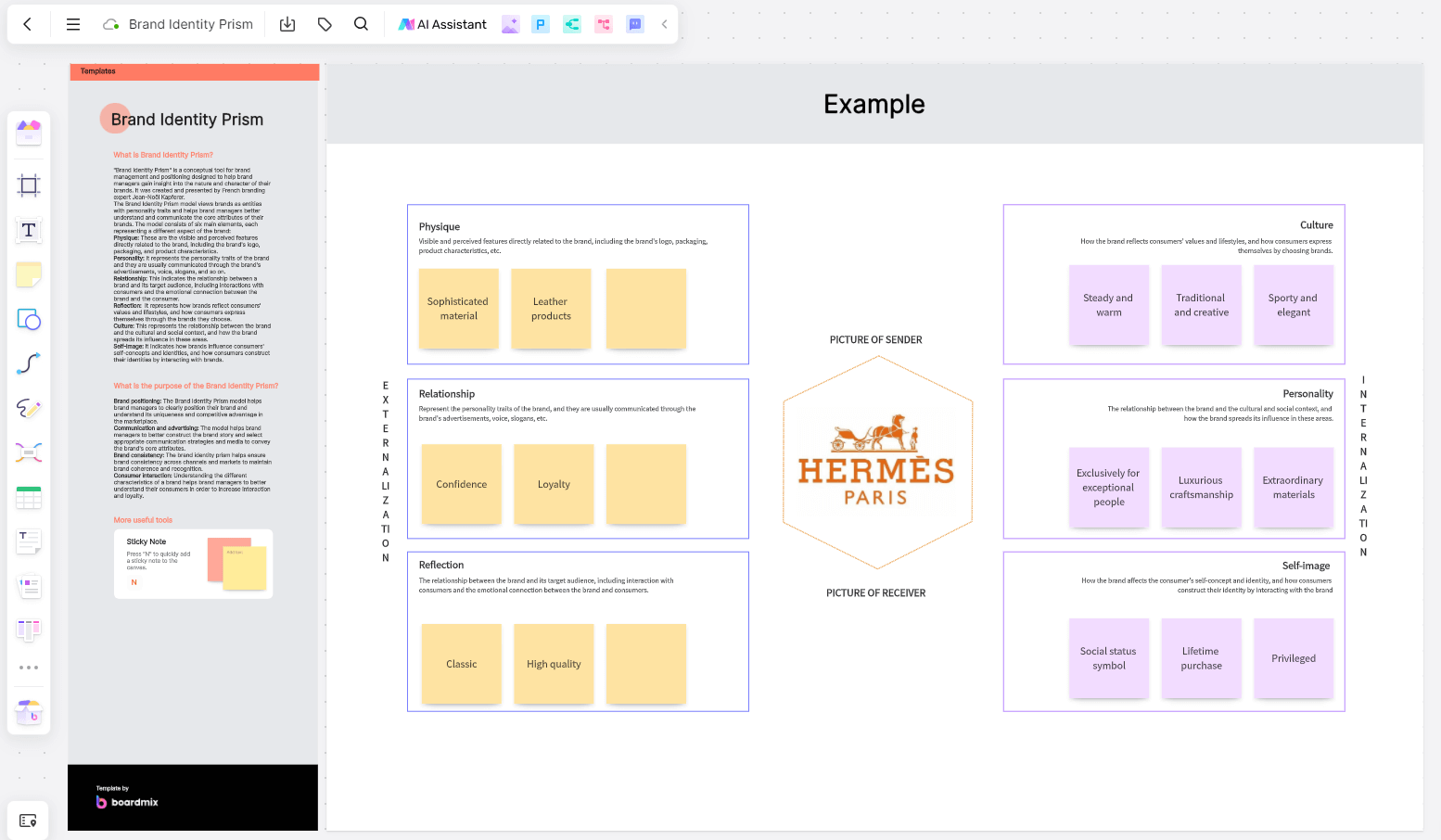
The Brand Identity Prism, sometimes known as Kapferer’s Brand Identity Prism, is a model developed by Jean-Noël Kapferer, a renowned expert in brand management. It offers a framework that presents the brand’s identity and image in the form of a hexagonal prism. The Brand Identity Prism model allows businesses to gain a comprehensive understanding of their brand identity, allowing for more effective brand management strategies. The six facets of this prism reflect and interact with each other to form the brand's unique personality.
The Brand Identity Prism consists of six facets:
Physique: This is the physical aspects and the core purpose of the brand - what it does, and what it offers.
Personality: This facet represents the character of the brand. It's how the brand communicates with its audience, including its tone of voice and style.
Culture: The culture represents the value system and principles that guide the brand. It's derived from the organization's history, origin, and the kind of employees it has.
Relationship: This aspect describes the relationship between the brand and its customers, which is often reflected through customer service or any direct interactions with customers.
Reflection: Reflection is how the consumer sees himself or herself when they use the brand. It's a mirror of the customer’s ideal self-image.
Self-image: The self-image is how consumers interpret themselves about the brand—how they feel when they use or engage with the brand.
Why Use Brand Identity Prism in Branding Strategy
The Brand Identity Prism model provides a multi-dimensional analysis of a brand's identity, aiding brands in understanding their unique personality and resonance with their audience.
1. Creates a Cohesive Brand Image
The Brand Identity Prism allows brands to establish a clear and cohesive brand image by analyzing each of its six components. A consistent brand image can create lasting impressions, fostering stronger customer relationships.
2. Aligns Brand and Customer Perceptions
Understanding the reflection and self-image aspects can help a brand ensure that its values and identity align with how its consumers perceive themselves and their ideal image. This alignment fosters customer loyalty and can lead to higher customer retention rates.
3. Builds a Unique Brand Personality
The personality facet of the prism assists brands in developing their voice and style. A distinctive brand personality can differentiate a brand from competitors and can become an essential factor in consumers' purchase decisions.
4. Enhances Customer Relationships
By understanding the relationship facet, brands can enhance their interaction with customers. Fostering meaningful relationships with customers can increase customer satisfaction and lead to long-term business success.
5. Encourages Internal Consistency
The physique and culture components aid brands in ensuring internal consistency—from the products/services offered to the company culture. This consistency is vital for maintaining trust with consumers.
6. Provides a Framework for Analysis
The Brand Identity Prism offers a robust framework for comprehensive brand analysis. This analysis can help in identifying areas of strength and those needing improvement.
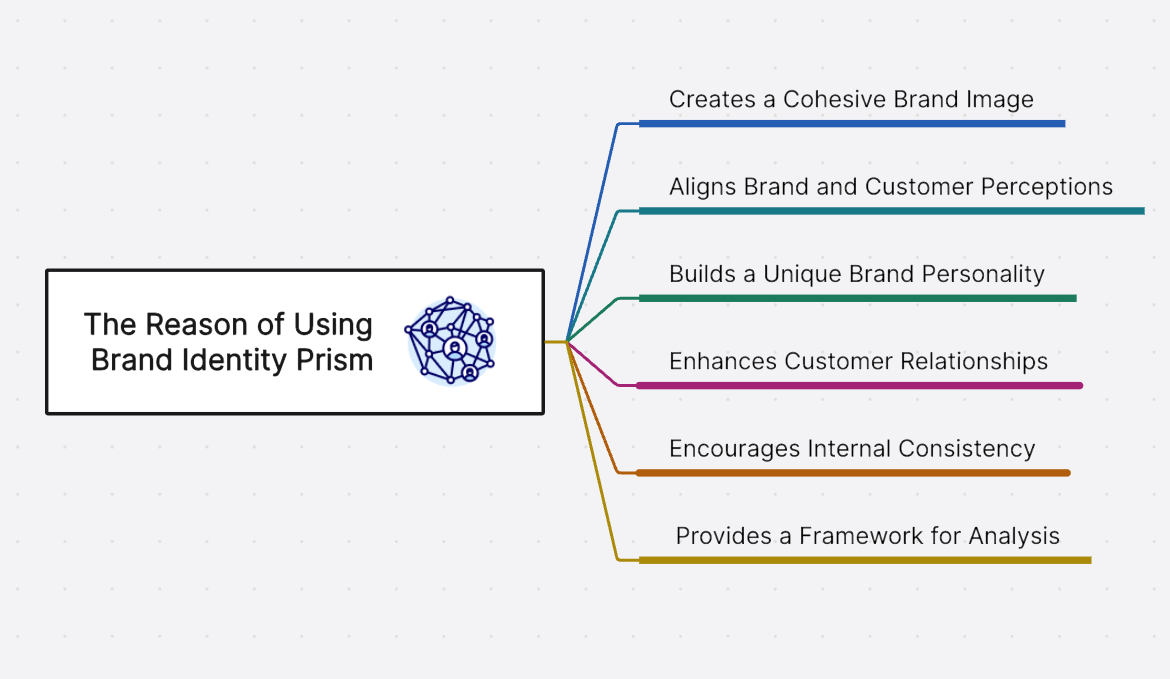
The Brand Identity Prism is a strategic tool that serves as a foundation for building powerful branding strategies, enabling brands to stand out in today's competitive marketplace.
How to Build a Strong Brand Using Brand Identity Prism
The Brand Identity Prism offers an excellent framework to understand, construct, and manage a brand's identity. With a robust tool like Boardmix, this process can be made simpler, more effective, and collaborative. Here's a step-by-step guide on how to build a strong brand using the Brand Identity Prism on Boardmix.
Step 1: Create a New Board and Use the Brand Identity Prism Template
Initiate your brand analysis by creating a new project and using the Brand Identity Prism Template. Boardmix provides many free ready-made templates and an interactive workspace where you can work on your brand identity and share insights with your team.

Step 2: Analyze and Define Each Facet of the Brand Identity Prism
In separate sections or columns on your Boardmix board, outline the six facets of the Brand Identity Prism: Physique, Personality, Culture, Relationship, Reflection, and Self-Image.
Then dive into each facet:
Physique: Identify the physical attributes and core purpose of your brand.
Personality: Define your brand's character, style, and tone of voice.
Culture: Describe the values, principles, and history that guide your brand.
Relationship: Evaluate how your brand interacts with customers.
Reflection: Determine how the consumer perceives themselves when they use your brand.
Self-Image: Understand how consumers feel when they engage with your brand.
For each facet, create sticky notes or text boxes in Boardmix to jot down key characteristics, strengths, and weaknesses.
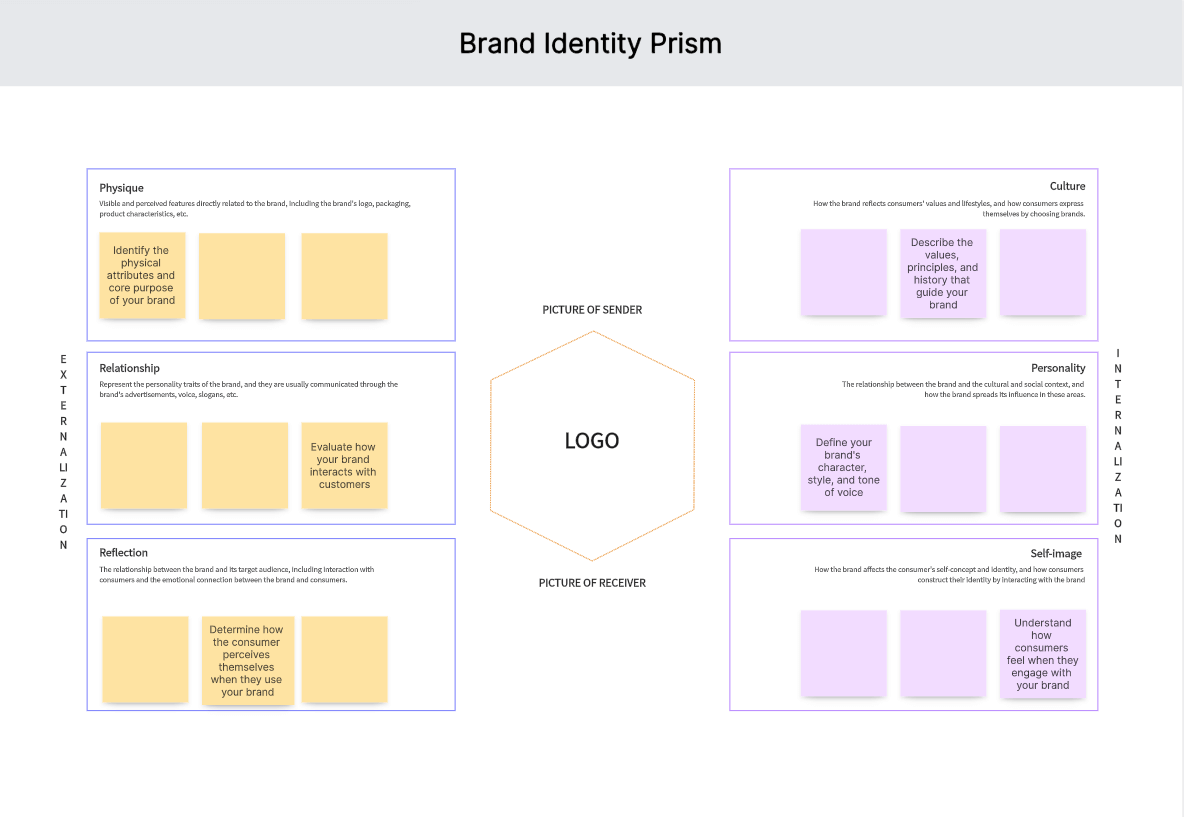
Step 3: Incorporate Visual Elements
To further enrich your analysis, add visual elements such as images, videos, or links that reflect each facet of your brand identity. Boardmix's intuitive design allows you to easily incorporate multimedia directly into your board.
Step 4: Develop Strategies for Improvement
Based on your analysis, develop strategies to enhance each facet of your brand identity. For example, you might decide to revamp your marketing communication to better align with your desired brand personality or introduce new customer engagement tactics to improve relationships.
Step 5: Share, Collaborate and Get Feedback
Share your Brand Identity Prism with team members or stakeholders using Boardmix's real-time collaboration feature. Collect feedback and ideas to refine your brand identity strategy further.
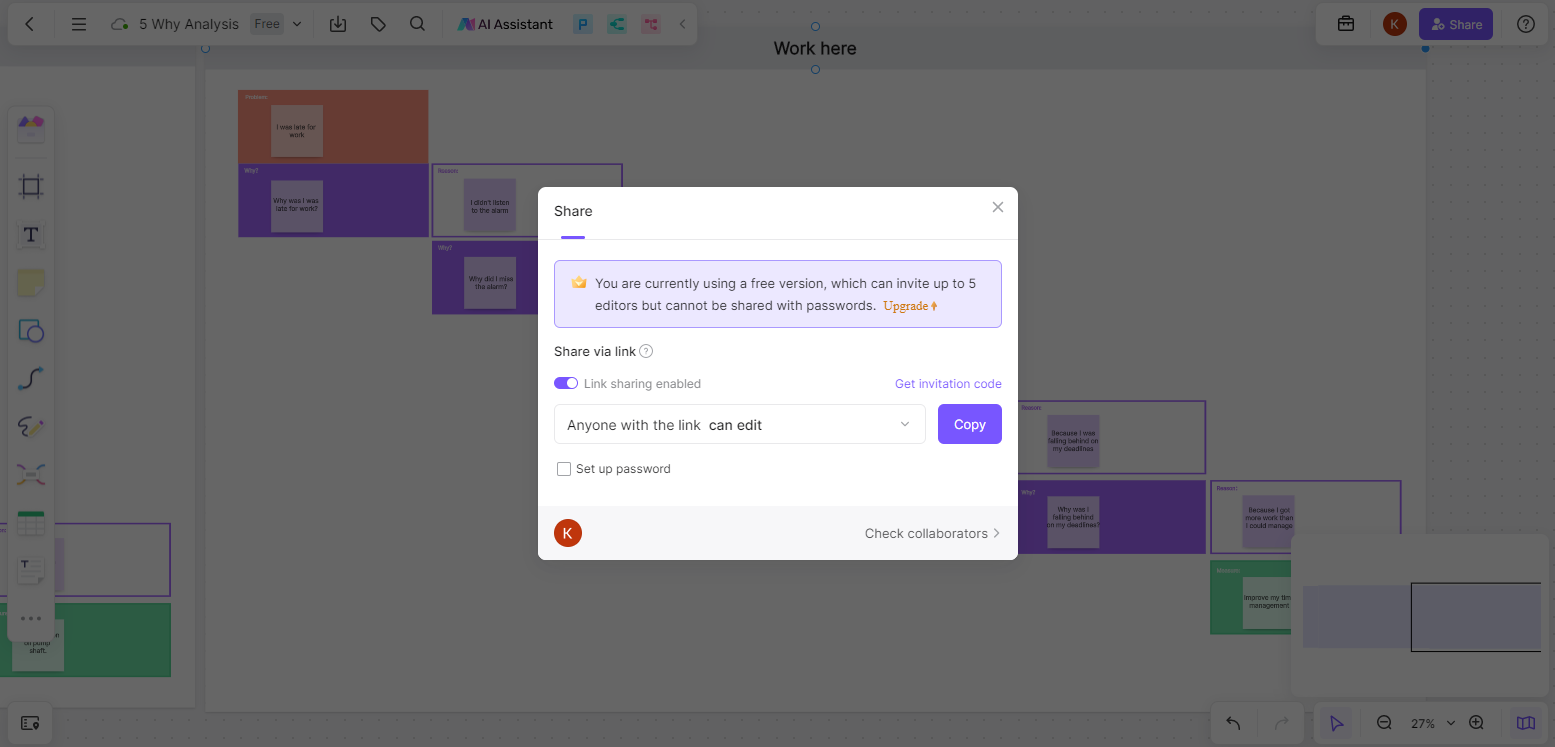
Step 6: Monitor Progress and Make Adjustments
Revisit your Boardmix board regularly to track the implementation of strategies and make adjustments as necessary. Use the version history feature to monitor changes over time.
Successful Brands: Brand Identity Prism Examples and Practice
Several well-established brands have effectively leveraged the elements of the Brand Identity Prism to build robust and unique brand identities. Below are a few Brand Identity Prism examples.
1. Apple Brand Identity Prism
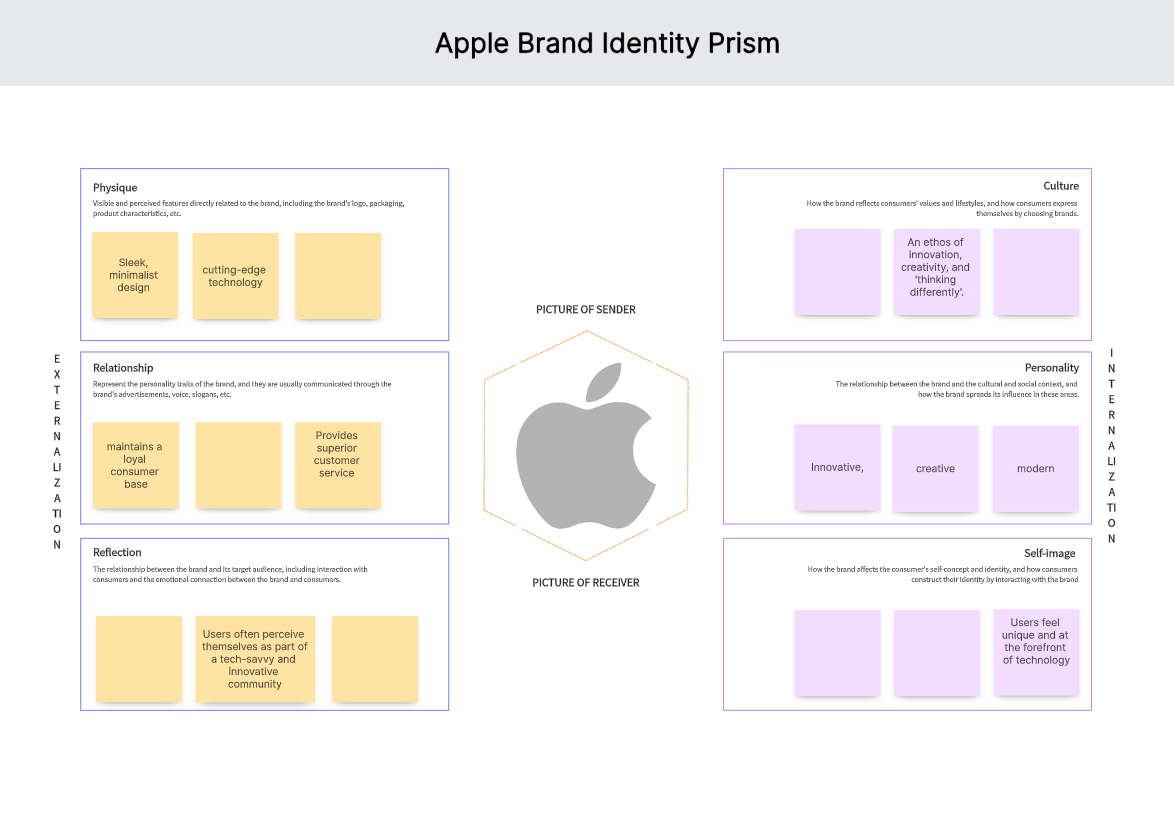 Apple is renowned for its distinct brand identity:
Apple is renowned for its distinct brand identity:
Physique: Sleek, minimalist design, and cutting-edge technology.
Personality: Innovative, creative, and modern.
Culture: An ethos of innovation, creativity, and 'thinking differently'.
Relationship: Provides superior customer service and maintains a loyal consumer base.
Reflection: Users often perceive themselves as part of a tech-savvy and innovative community.
Self-image: Users feel unique and at the forefront of technology.
2. Nike Brand Identity Prism
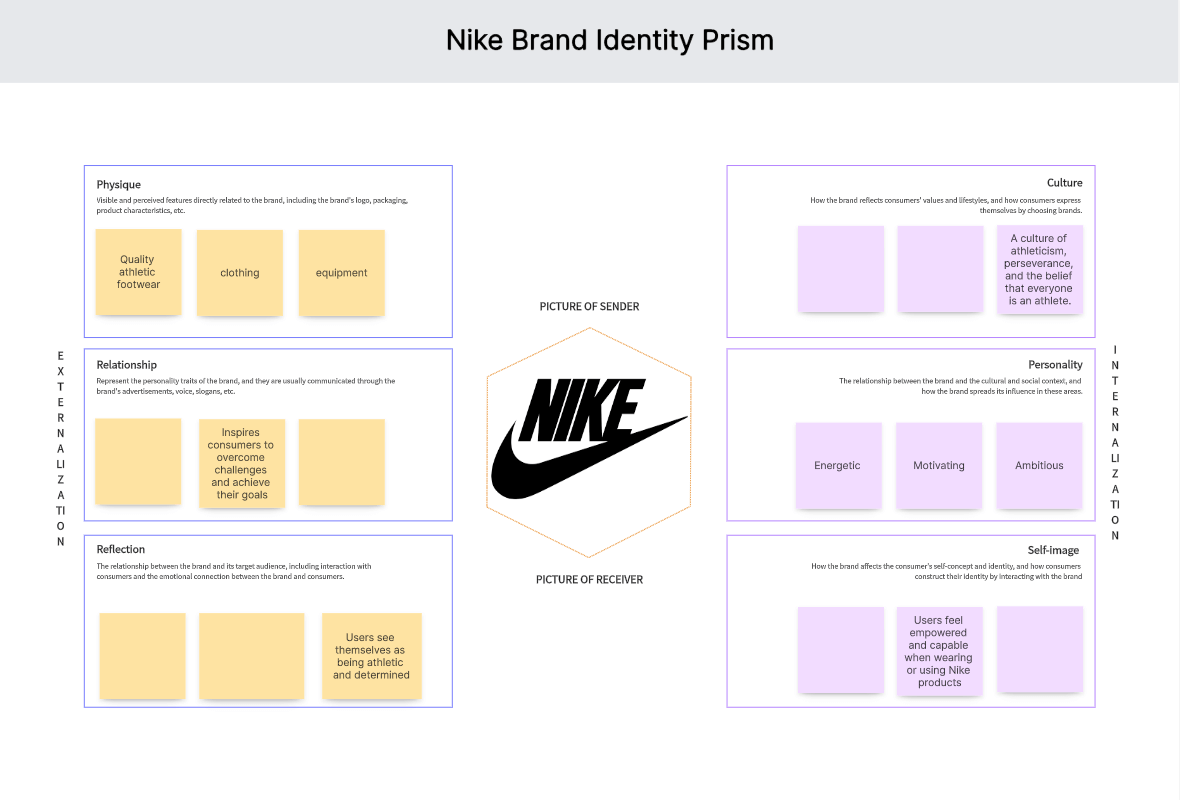
Nike's brand identity strongly resonates with its customers:
Physique: Quality athletic footwear, clothing, and equipment.
Personality: Energetic, motivating, and ambitious.
Culture: A culture of athleticism, perseverance, and the belief that everyone is an athlete.
Relationship: Inspires consumers to overcome challenges and achieve their goals.
Reflection: Users see themselves as being athletic and determined.
Self-image: Users feel empowered and capable when wearing or using Nike products.
3. Starbucks Brand Identity Prism
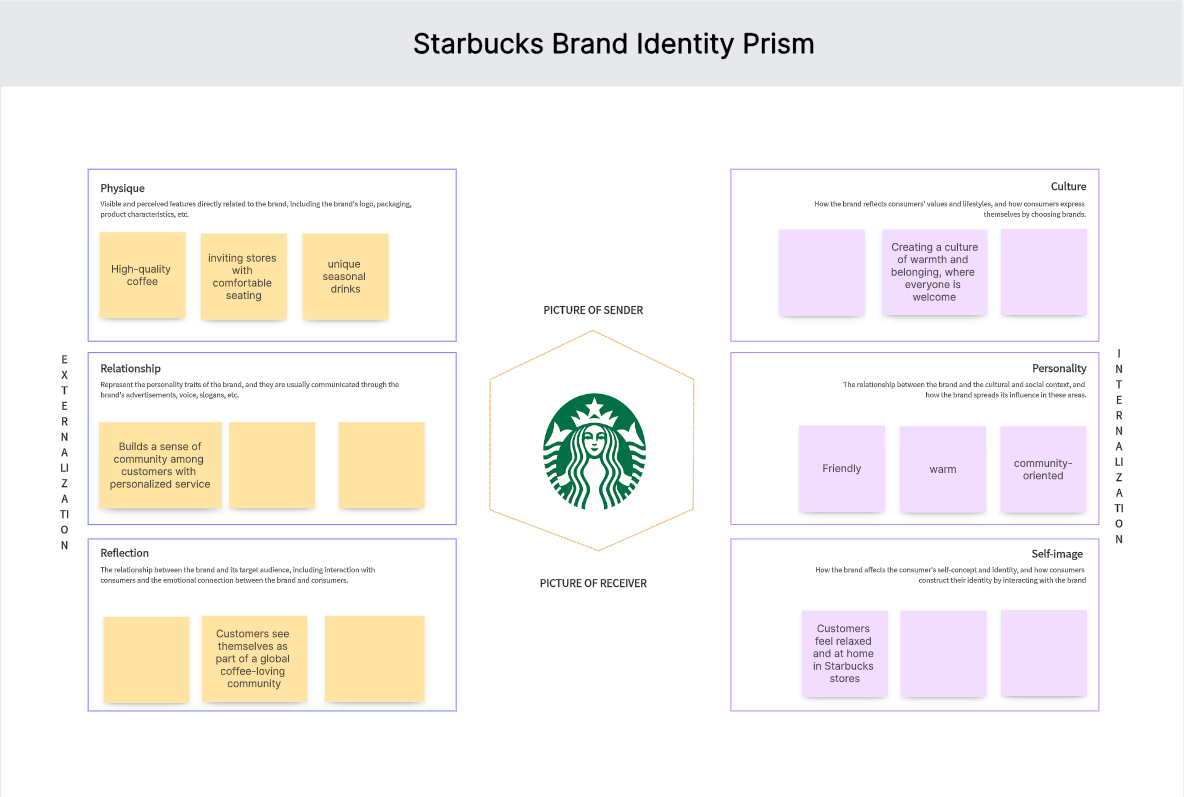
Starbucks has established a recognizable brand identity:
Physique: High-quality coffee, inviting stores with comfortable seating, and unique seasonal drinks.
Personality: Friendly, warm, and community-oriented.
Culture: Creating a culture of warmth and belonging, where everyone is welcome.
Relationship: Builds a sense of community among customers with personalized service.
Reflection: Customers see themselves as part of a global coffee-loving community.
Self-image: Customers feel relaxed and at home in Starbucks stores.
Each of these brands' strong identities has helped them establish significant market presence and consumer loyalty. They provide excellent examples of how to effectively apply the Brand Identity Prism to create a successful brand.
Tips for Using the Brand Identity Prism Effectively
The Brand Identity Prism offers a practical framework for understanding and shaping a brand's identity. But like any tool, its effectiveness depends on how you use it. Below are some tips for using the Brand Identity Prism effectively.
1. Understand Each Facet Fully
Before applying the model, it's crucial to thoroughly understand each facet of the prism and what it represents. Be sure to spend time on this step, as a solid understanding of these elements will drive your brand development process more effectively.
2. Incorporate Consumer Insights
Customer perception is an integral part of the Brand Identity Prism (seen in the facets of reflection and self-image). Therefore, incorporating customer feedback, conducting market research, or using consumer insights can add depth and accuracy to your analysis.
3. Maintain Consistency
Ensure that your brand’s six facets are coherent with each other and consistent over time. Consistency helps build trust and recognition, thereby solidifying your brand identity.
4. Be Unique and Authentic
Identify what makes your brand unique, and ensure that your brand's personality, culture, and other aspects are authentic. An authentic and unique identity sets you apart from competitors and is more likely to resonate with customers.

5. Keep Evolving
Although consistency is crucial, it's equally essential for a brand to evolve with time. Regularly revisit and update your brand prism to align with changing market trends, consumer preferences, and the company's growth.
6. Use Visuals
Using visual aids or mood boards while working on each facet can help you better capture your brand's essence. Visual elements can also make the process more engaging and understandable for all stakeholders involved.
7. Apply it Holistically
Don't use the model in isolation. Consider other business aspects like marketing strategies, product development, customer service, etc., while defining your brand prism.
8. Involve Your Team
The Brand Identity Prism is not just a top-level management tool. Including different perspectives from various team members can lead to a richer, more well-rounded brand identity.
These tips can help you make the most out of this framework, ensuring a strong foundation for all branding efforts.
Conclusion
The Brand Identity Prism is an invaluable tool in building a unique and robust brand identity. Paired with the versatile capabilities of Boardmix, you can create a comprehensive analysis and strategies that drive successful brand development. By illuminating the multifaceted nature of a brand's identity, this framework empowers businesses to transcend mere products or services, forging deeper emotional connections with consumers. Start to build your Brand Identity Prism on Boardmix now!














